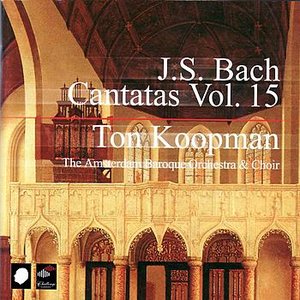Auf Christi Himmelfahrt allein, BWV 128
On Ascension alone ( BWV 128 ) is a church cantata by Johann Sebastian Bach. He composed it in Leipzig for the Ascension Day and first performed it on May 10, 1725 for the first time on.
History and words
In his second year in office Leipzig Bach had to Palm Sunday consistently composed chorale cantatas for his second cantata cycle from the first Sunday after Trinity, but was passed over for Easter again cantatas on freer textual basis. These included nine cantatas on texts of the poet Christiana Mariana von Ziegler, including the Cantata for the Feast of the Ascension. Later Bach arranged to most of them his third cantata cycle, but this Cantata for Ascension and Pentecost Cantata BWV 86 He Reserve left in the second cycle, possibly because they start as the pure chorale cantatas with a chorale fantasy, while the others often open with a solo set, the is entrusted to the bass as the Vox Christi.
The prescribed readings for the feast day were 1.1 to 11 Acts LUT and LUT Mk 16.14-20, the mission and baptize and the Ascension. The poet who often chooses the personal ego took shape, as the theme of the cantata the first verse of Ernst sun 's Choral after Joshua Wegelin ( 1636): After Jesus ascended to heaven, nothing can stop me longer on the earth, as is promised to me, to see him face to face (1 Cor 13:12 LUT). In sentence 2, the poet plays at on the Transfiguration of Jesus (Mt 17.4 LUT), sentence 3 sees the inscrutable omnipotence of Jesus everywhere and not only bound to one place. He will raise me on his right hand (Mt 25,33 LUT) and judge me fairly, so says the final chorale, the fourth verse of O Jesus, my desire of Matthew Averius.
Ziegler's text differs from the printed edition (1728) from the cantata text. Perhaps Bach joined themselves by a leading thoughts about "where my Redeemer lives ", an aria and a recitative to a set.
Scoring and structure
The cantata is festively decorated with three soloists, alto tenor and bass, four-part choir, and an extremely versatile instruments of two horns, two oboes, oboe da caccia, trumpet, oboe d' amore, two violins, viola and basso continuo.
Music
In the opening chorus of the chorale melody of God alone is in the Hoh honor of Nikolaus Decius in an orchestral concerto was installed. The cantus firmus is sung by the soprano in long notes while the lower voices are done in imitation. The motifs orchestra are derived from the first line of the chorale melody: A signal - topic, which is first, then played by the strings and oboes of the horns, contains the first five notes of the melody, a fugue subject contains all nine tones of first melody line, so that " a true differentiated in the manner set but uniform in the subject material Choralbearbeitung created " (Alfred Dürr ).
Bach used the trumpet, the royal instrument of the Baroque, in Theorem 3, to signal that the Lordship of Jesus is now upon us. The trumpet appears first in the ritornello, then takes over the singing voice its theme, eventually they will sound again, while the voice is built into the set. After a central part of the beginning is not there repeatedly capo, but the pasted idea sounds as strings accompanied recitative. Then only the ritornello is repeated.
The following duet has intimate character. The obbligato instrument in the score called organo, but the voice is advertised for oboe. Your range can not be represented by an oboe, but probably an oboe d'amore. Perhaps Bach changed his sound idea already during the transcript, or he changed the name later. Max Reger used the ritornello of this sentence as the subject of his Bach Variations op 81
The cantata concludes with a four -part chorale, who is played by most instruments colla parte, while the horns are managed separately because of their limited Tonvorrats.
Recordings
- Bach Made in Germany Vol 1 - Cantatas V, Günther Ramin, St. Thomas Boys Choir, the Gewandhaus Orchestra, Lotte Wolf- Matthew, Gert Lutze, John Oettel, Eterna 1953
- Bach: Sacred Cantatas 13 & 13 Sinfonias, Helmut Winschermann, Kantorei Barmen- Gemarke, German Bach Soloists, Julia Hamari, Kurt Equiluz, Hermann Prey, Philips 1971
- The Bach Cantata Vol 35, Helmuth Rilling, Gächinger Kantorei, Bach-Collegium Stuttgart, Gabriele terror Bach, Aldo Baldin, Wolfgang Schöne, Haenssler 1981
- J. S. Bach: The cantatas - Sacred Cantatas Vol 7, Gustav Leonhardt, Hannover Boys Choir, Collegium Vocale Gent, Leonhardt Consort, René Jacobs, Kurt Equiluz, Max van Egmond, Teldec 1983
- J. S. Bach: Ascension Cantatas, John Eliot Gardiner, Monteverdi Choir, English Baroque Soloists, Robin Blaze, Christoph Genz, Reinhard Hagen, Archiv Produktion 1993
- J. S. Bach: Complete Cantatas Vol 15, Ton Koopman, Amsterdam Baroque Orchestra & Choir, Bogna Bartosz, Jorg Dürmüller, Klaus Mertens, Antoine Marchand 2001
- J. S. Bach: Cantatas Vol 35 ( Cantatas from Leipzig 1725), Masaaki Suzuki, Bach Collegium Japan, Robin Blaze, Makoto Sakurada, Peter Kooij UNTIL 2001
- J. S. Bach: Bach Edition Vol III -28, Pieter Jan Leusink, Holland Boys Choir, Netherlands Bach Collegium, Sytse Buwalda, Nico van der Meel, Bas Ramselaar, Brilliant Classics 2010









